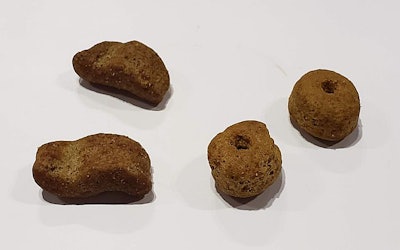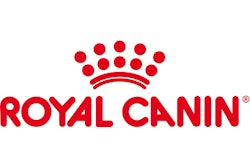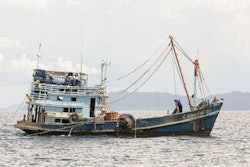
The all-consuming maw of a Labrador Retriever differs from a brachycephalic Boxer’s bite, which influences those dogs ability to eat specific shapes of kibbles. Pet food product developers vary the shape, texture, size, density and other factors of kibble to influence feeding behavior.
“It's not always what's in the product that makes it unique and helpful. It can be just the way that we make it,” Jason Taylor, National Sales Director with Royal Canin USA, “The size and shape of kibble influences the ability of dogs and cats to eat that kibble... Everything from the shape to the bulk density to the grind size all factor into, number one, their willingness and desire to eat the products, and two, their ability to eat the product based on how their mouths are built.”
For example, Persian cats use their tongues like tiny backhoes. They scoop food with the bottom of their tongues, which makes certain shapes of kibble difficult for them to pick up. Persian cat breeders noted that their cats tended to eat specific pieces of kibble to the exclusion of others. After those breeders asked Royal Canin if they could provide cot food using just those preferred shapes, the pet food company began developing a breed specific variety for Persians.
Specially shaped kibble helps dogs' feeding
Labrador Retrievers also benefit from non-conventional kibble shapes. Labs tend to eat quickly, which can lead to health problems, particularly bloat.
“One thing we know about Labradors is that they are voracious eaters,” Jill Cline, PhD, site director for Royal Canin Pet Health and Nutrition Center said. “They don't even need teeth, honestly. That is not something you can change through nutrition, but through understanding feeding behavior we can make changes in the way we deliver nutrition.”
To create a food that would slow down Labrador’s eating, Royal Canin developed a large kibble with a hole in the middle.
“A lot of people think that small kibble is what you should feed dogs that feed voraciously, but studies have shown that small kibble can actually exacerbate some of the potential conditions associated with certain conditions, like bloat,” Cline said. “So, forcing these guys to chew their food does two things. One, it hopefully make them feel more full, because just like your mom told you to chew your food 12 times, there's a feedback loop between a nerve in the jaw and your brain that tells your brain you are chewing. Evolutionary the only reason that this muscle should be working is that your eating.
“That's one reason, the other is that if we ask them to chew it lengthens the time of the meal for them, and a longer meal time has been shown in epidemiological studies to help decrease one of the risk factors with bloat.”
When Royal Canin first introduced their Labrador Retriever formulation to dog breeders, many were skeptical, Taylor said. People thought the kibble was too large, or that it was just marketing. However, once they tried it, breeders found that the large, donut-shaped pieces really did force the Labs to slow down and chew, instead of just inhaling their food.
“We try to find shapes that are going to fit the conformation of their mouths,” Taylor said. “This kibble technology, some people might want to roll their eyes at it, but there is real science behind this. The right shape of kibble for a Yorkie is very different than for a Bulldog. They are built differently. Their heads are different. Their mouths are different. The way to get them to eat effectively and also to eat in a healthy way is what's behind all that technology.”


















